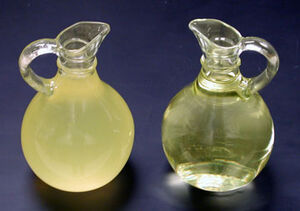
Soybean oil
About Soybean oil[]
Wikipedia Article About Soybean oil on Wikipedia
Extracted from soybeans, this light yellowish oil is high in both polyunsaturated fats (58 percent) and monounsaturated fats (23 percent), and low in saturated fats (15 percent). it's used extensively in the United States in the manufacture of Margarine and Shortening. Soybean oil has always been popular as a cooking oil in Chinese cuisine and is gaining favor in the United States because it is inexpensive, healthful and has a high smoke point.
In processing soybeans for oil extraction and subsequent soy flour production, selection of high quality, sound, clean, dehulled yellow soybeans is very important. Soybeans having a dark colored seed coat, or even beans with a dark hilum will inadvertently leave dark specks in the flour, an undesirable factor when used in food products. All commercial soybeans in the United States are yellow or yellow brown.
To produce soybean oil, the soybeans are cracked, adjusted for moisture content, rolled into flakes and solvent-extracted with commercial hexane. The oil is then refined, blended for different applications, and sometimes hydrogenated. Soybean oils, both liquid and partially hydrogenated, are exported abroad, sold as "vegetable oil," or end up in a wide variety of processed foods. The remaining soybean husks are used mainly as animal feed.
The major unsaturated fatty acids in soybean oil triglycerides are linolenic acid,C18:3; linoleic acid, C-18:2; and oleic acid,C-18:1. Soybean oil has a relatively high proportion, 7-10%, of oxidation prone linolenic acid, which is an undesirable property for continuous service, such as in a restaurant. Two companies, Monsanto and DuPont/Bunge in 2004 introduced low linolenic,(C18:3; cis-9, cis-12, cis-15 octadecatrienoic acid) Roundup Ready soybeans: the former introduced a new soybean seed variety called "Vistive" and the latter Pioneer seed variety 93M20. Dupont/Bunge is marketing its low linolenic soybean oil under the brand name Nutrium. The idea is that reducing or eliminating the triple unsaturated fatty acid, linolenic, also eliminates the tendency to be a paint-like drying oil producing noticeable rancidity. In the past hydrogenation reduced the unsaturation in linolenic acid but produced the unnatural trans fatty acid trans fat configuration whereas in nature the configuration is cis.
One unintended consequence of moving away from partially hydrogenated soybean oil (containing trans fatty acids) is the switch back to naturally saturated palm oil for frying, especially in China. This fact is resulting in a severe threat of deforestation to pristine forests in Indonesia followed by the planting of palm oil plantations.
